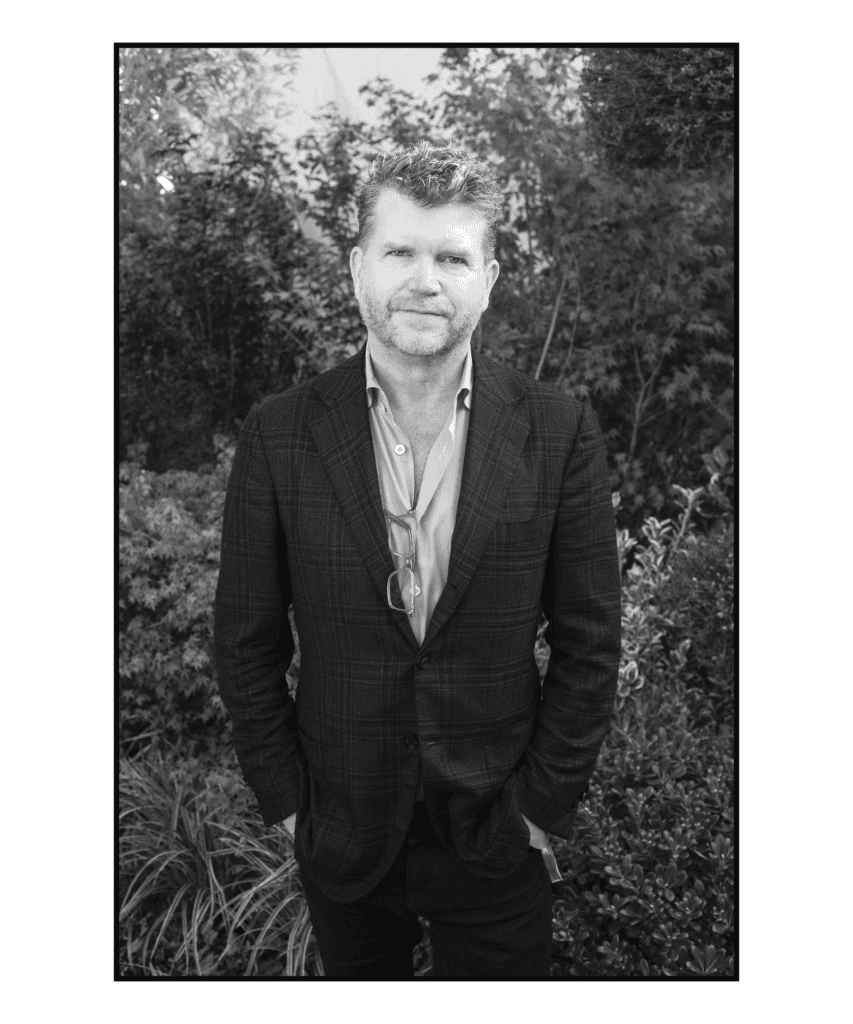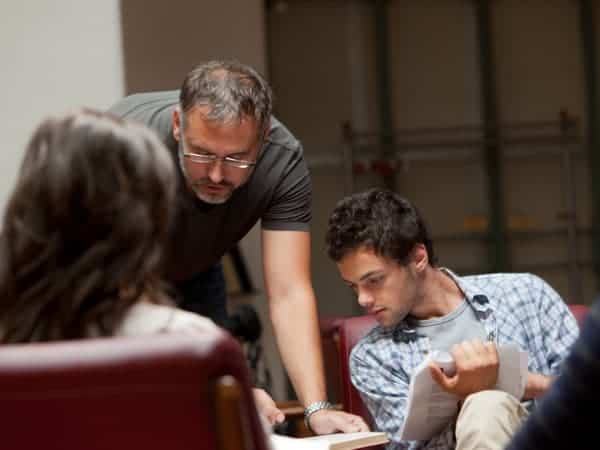Office Hours: 30 minutes with Matthew Barzun
Matthew Barzun has always been fascinated about how we can stand out and fit in at the same time. He helped countries do both when he served as US Ambassador to the United Kingdom and to Sweden. He helped citizens do both as National Finance Chair for Barack Obama by pioneering new ways for people to have a stronger voice in politics. And he helped tech consumers do both as an entrepreneur when he helped start CNET Networks in the early 90’s. Barzun was raised on the East Coast, started his career on the West Coast, and settled in the middle in Louisville, Kentucky with his wife, Brooke, and their three children.

You’ve built a book about leadership which promotes sharing leadership and empowering everyone in a group to bring something to the table. What’s the origin story of that idea?
When I was writing this book, I always knew the antagonists I had in mind. Villain is too strong a word for what I’m thinking. But I knew that the “pyramid” mindset, meaning hierarchical and representing the world of top-down processes was the antagonist. I knew that because I’d seen, both as I was growing up and in my professional lives in the dot-com world and later in presidential politics and diplomacy, that despite what we learned in science class, which told us energy is always conserved and never destroyed, in human affairs, the same principles don’t apply. Every time I was gathered around a table with people, I was sensitive, perhaps more than the average person, to how people’s energy could either be created and kindled or smothered. It’s not just jerky people who do that smothering, disempowering or cutting off, but it’s also good, decent people who think that that’s what leadership looks like and that that’s how meetings work. I saw the ways that those approaches would kill initiative in groups.
For a long time, my working framework was the pyramid vision vs. the “blank” – I didn’t know how to describe what I intuitively understood as the rival. I also, eventually, didn’t want the “versus,” because I simply wanted to develop an alternative. I thought about using “snowflake,” but that became a political word. Then, in Chicago, I was looking at the back of a dollar bill, and I saw above the eagle, this thing that looked like a fuzzball. On Wikipedia, I researched the Great Seal of the United States and discovered the radiant constellation: the symbol for how you pursue diversity without division, unity with individuality. It was the perfect symbol.
At REAL, we’re so excited about this vision of gathering people together. It really is, in some ways, a civic mission to think about how we can use classrooms to move toward that democracy-driven ideal of unity with individuality that you just named. What does it look like to raise kids to operate in a constellation model like the one you describe in your book?
The honest answer is that I don’t know. I have ideas for adults but would presume to try to educate educators of kids. I do know that there’s a lot that we shouldn’t do. I often draw a picture on a whiteboard that sets off space at each corner, each space representing a “rocky shore,” or a thing to be mindful of and avoid. The happy space is in the middle. what I picture when I imagine answering this question.
One of the rocky shores is centering one specific kind of temperament in workplaces or, by extension, education spaces. The instinct in those spaces is to get the hand-raisers, the people who are disproportionately interested. The types of kids who raise their hands for Model UN, Mock Trial, and other similar activities in high school often become the same ones who stay at the center of power as we grow into adults. We tend to try to mold all of us into this type. However, to the extent that you believe in Myers-Briggs or other temperament typing mechanisms, the world tends to organize into 4s: four houses in Harry Potter, four gospels, etc. So you’re leaving out three of four other types. That’s most of us.
The interested ones, the handraisers, often cluster under a particular temperament. They like rules and gatekeeping. We wouldn’t survive without them. But it’s not the only temperament that should be represented, and it crowds out other thinkers from access to the conversation.
The other rocky shore is the “middle school science project” idea. By this I mean a gathering or initiative that lacks rigor, in which one person does all the work and everyone else tags along. It usually feels fake. It’s the reason that labs in school science classes can be terrible even when taught by good teachers. They say “take this, mix in this compound, and you’ll get nylon.” It takes away the surprise and the discovery because it’s too easy. I could just read a sentence explaining this would happen. Where’s the drama? Where’s the learning? Some types of learners might be amazed, but what’s missing there is uncertainty. Kids are good at knowing if something is BS or not.
Another rocky shore would be the idea of a “group hug,” the “hey, what unites us is greater than what divides us” model. I’m not so sure about that. That idea makes people afraid of difference. What Mary Follett, the matron saint of the Constellation mindset, says is that difference is where a group’s energy lies. Branching, breaking, and differing is how we grow. We shouldn’t be scared of it. If you can constructively engage difference, you can create an exciting, well-functioning space.
I don’t know what the other rocky shores are yet around education. I would say that most of the instincts that we, adults, have about sharing the power of work, discovery, and vision aren’t very good.
Oftentimes, these days, companies and schools and groups talk about “making space” for new voices, but it also sounds like fashioning a space in which all people can exist as themselves might be more productive than just inviting new people in.
We often hear the cliche that “we need bridges, not walls.” I don’t find that a useful framework, because you could build a useless bridge to nowhere, and there are lots of walls that are incredibly helpful. I want to look at the cliché through the Pragmatic framework, the philosophy co-developed by William James and other. It would ask, “Does the wall or bridge make the world more or less like what we want it to become?” The idea of the bridge comes from a good place, but we have to remember that nobody lives on a bridge. A bridge is a means of travel. Also, you don’t build a bridge from the middle. If you watch a bridge built, for the whole first year it looks like they’re building two walls on either side of the river. With individuals, if you want bridging to happen, the first step is to foster a space of self-definition: who you are, where you stand, what you stand for. Then, from there, people can start to see the other, acknowledge the other, listen to the other, and then finally have that “bridge” moment of seeing yourself in them.
That practice of self-definition and “bridging” certainly connects to and roots a lot of teaching practice, and this vision of what a shared space looks like transfers meaningfully to education. What, in your mind, are differences between the workplace and educational spaces when we think about sharing power?
I did spent a lot of time with eighteen-year-olds at one point, when I interviewed twenty thousand kids in the United Kingdom. I led workshops because I wanted to learn about them and how they perceived the United States. What I learned was that young people are capable of thinking like adults. C.S. Lewis offered the advice that the best way to write great books for children was to not treat them as children. His point, in my mind, was that there’s so much condescension toward children, but they can handle most material. In his “children’s” books, children encounter murder and all kinds of “difficult” subjects. When I led those workshops with British kids, I asked what frustrates them about America. They were focused on real issues: they said that they thought about drones, guns, racism, and the Israel/Palestine conflict.
I’d also ask those kids: “who likes to lose an argument?” And, of course, generally speaking, nobody likes to lose an argument. We spend a lot of time convincing people to be in the argument winning business, but that probably isn’t productive for creating a space in which people can share power.
I do imagine a lot more similarities between the spaces than differences. I don’t know classrooms that well, and so I know I’m not an expert, but I’d treat the eighteen-year-olds like full grown-ups. But I also treat everyone as a learner. When I was in that role, I would ask my senior team – full of people who were in their 50s – to do things like draw me a picture of a good or bad day at work. These people are extraordinary. They have graduate degrees and endless qualifications, but I wanted them to do something they’re not as good at as they are with words. It’s amazing what you learn when you ask people to try something in a new way. It gets them to open up.
I’ve found that nonsense questions, or questions that pull everyone in the room out of their own areas of mastery and expertise, can be a powerful way to bring my students into a conversation as equals.
With my team, I’d write “ALSO” in all caps on a whiteboard. Then, I’d write “also” underneath it in lowercase letters. Every person in the room would be good at Arguing, Lecturing, Securing (this is a big skill in the State Department, but in a corporate world I’d say “strategizing”) and then Organizing. That is the definition of leadership for most of their people. But what else is there? You could make the L lead, of course. All of these skills are all sort of hard and sharp – they’re the all-caps ALSO. Then, I’d say okay, cool, good for us. I want to explore what else spells “also”: asking others about hopes and fears, linking them to your own, serving the overlap between the two of you, and in the process, opening up. That’s not a linear process; rather, all of that can happen at once. These skills, and the process of implementing them, is not intuitive for many people. Giving them the permission to try these other, less familiar skills can be empowering. It really works. What the lowercase “also” skills have in common is that they help teams to embrace uncertainty and turn it into a positive experience. Those capital letters are trying to factor out uncertainty.
Fear of uncertainty is huge when we talk to students about entering into discussions during a class. Kids also have reservations about entering into uncertain territory or making claims that might not be “right,” but teachers struggle with that hesitance, because teachers generally really hope that their students will take risks in the classroom. Fostering a space where students face uncertainty is one of teaching’s biggest challenges.
I has a colleague who was thinking about this with me one day. He said, in our world (the State Department), doing something good is +10, but a bad thing is -10000, and it follows you forever. This guy made this great point that yes, you can’t calculate the exact impact of your move, but you can quantify that there’s a lot less love or trust after a moment of miscalculation in response to uncertainty. To my mind, we shouldn’t run away from quantifying these more abstract, hard-to-pin-down thoughts or moments because they can force us to see the culture we’ve actually created, not the one we think we have.
The idea of quantifying impact translates directly into teaching. One challenge that teachers face is quantifying or naming progress and growth in relation to these more uncertain or amorphous skills and challenges, like the ability to link others’ hopes and fears to your own or open up. As we implement these processes to try and foster environments in which people share power, how can we build those skills and also measure their success, particularly for kids?
In my next book, I’m hoping to get more practical and tactical about how this process can work in schools, in philanthropy, and in other such organizations. My answer, for now, is imperfect. We can start by noticing that teachers and students by and large have been living in hierarchical pyramids, because most of our institutions are pyramids. We’ve gotten good at the habits of the pyramid. When you sit down at your first faculty meeting or kindergarten: you pay attention to and internalize that hierarchy, asking and answering, “Who’s in charge? What’s the point? Where do I fit in?” We stop noticing it, but that’s what we ask ourselves all the time. In a new job, you’re super aware of it. We establish what I think of as the habits of a pyramid: we get good at knowing who’s up and who’s down, we develop focus, and we excel at chopping things into their component parts. That’s what we’re good at.
As and when we try to also build habits of democracy and interdependence, we begin to see the impact of the habits of a pyramid. We begin to see that we’ve lost our awareness of other kinds of order. The order of the night sky, for example, or a tidal pool, your favorite song, or a soccer field, still exist, they’re just not hierarchical in the same familiar way. Then, as we’ve become good at focus, we’ve also gained a kind of tunnel vision, and we don’t notice things on the side or behind us. Then, as we’ve gotten good at chopping things up, we’ve lost the feel for things that cannot be understood in that reductive way.
In a corporate setting, you can’t just understand the customer experience or a competitive landscape through these habits of a pyramid – those essential elements that we’re trying to deal with aren’t isolated in one level of a pyramid structure. Similarly, with kids, something like team spirit or the energy of a classroom doesn’t lie in the hands of one level of the pyramid. Students know such feelings and forces are real, but they can’t be reduced to a simplistic structure. That can be an entry point into thinking about the less tangible skills, because they’re often related to those kinds of concepts.
The endemic anxiety among teenagers makes that kind of work really challenging for students, so it’s certainly at the top of many of our (teachers’) minds. Another thought in my mind is the fact that the most privileged students are often the ones who exist in school spaces that challenge or disrupt hierarchical systems, and the least privileged students are often in the most hierarchical spaces.
Music is important to me. I’m not a musician. The music that kids listen to is important and can be an access point into power sharing for anyone. Music is not linear; it’s not hierarchical. It’s turf that feels like any listener’s own.
Thank you so much for joining us, Matthew!






